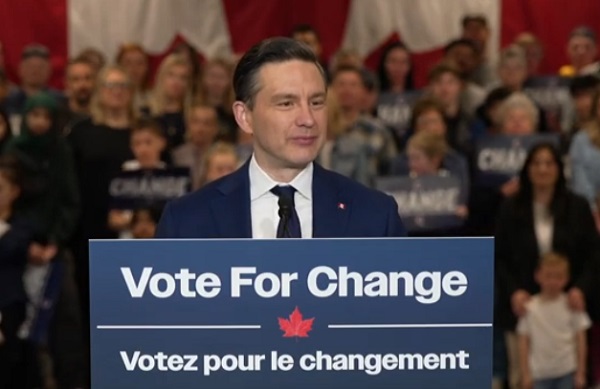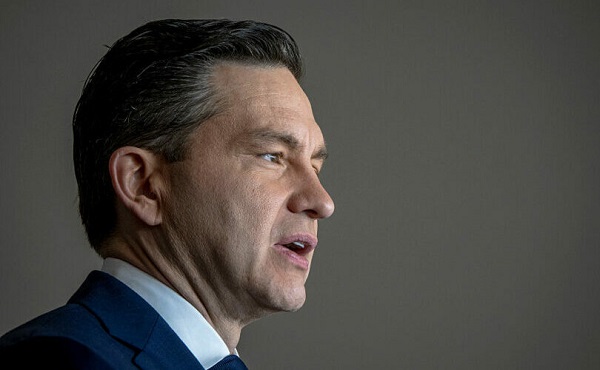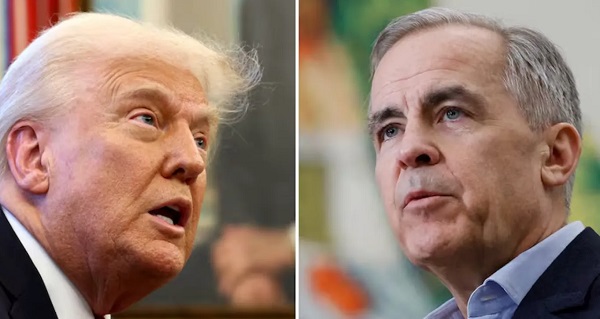Business
Bitter legacy hangs over today’s energy discussions between Quebec and N.L. premiers
Newfoundland and Labrador Premier Andrew Furey and Quebec Premier François Legault pose in the office of the premier at the Confederation Building, in St. John’s, on Friday, Feb. 24, 2023. THE CANADIAN PRESS/Paul Daly
By Sarah Smellie in St. John’s
As Quebec Premier François Legault seeks a new energy deal with Newfoundland and Labrador, he faces a public in the Atlantic province scarred by the legacy of a pair of hydroelectric projects mired in missteps.
Legault travelled to St. John’s this week for discussions with Newfoundland and Labrador Premier Andrew Furey about the 1969 Churchill Falls hydroelectric energy deal — and what will come after it ends in 2041. The lopsided deal heavily favours Quebec, and has left a lasting bitterness in Newfoundland and Labrador.
The two leaders are scheduled to speak with reporters later on Friday after the meeting.
Jeff Webb, a historian at Memorial University, says some residents of Newfoundland and Labrador think the province wouldn’t have endured the “humiliation” of needing equalization payments from the federal government if the Churchill Falls agreement had more evenly served both provinces.
“It does speak to people’s sense that this is something that’s always been rightly ours, and it’s been stolen,” Webb said in a recent interview.
Decades later, that hostility drove people in Newfoundland and Labrador to embrace the Muskrat Falls hydroelectric project, which is long delayed and draining the provincial purse, Webb said.
The 1969 Churchill Falls deal allows Quebec’s provincially owned hydroelectric utility, Hydro-Québec, to purchase 85 per cent of the electricity generated by the dam in Labrador, and therefore reap most of the profits. As of 2019, the deal had yielded close to $28 billion in profits to Quebec, and about $2 billion for Newfoundland and Labrador.
Under the agreement, Hydro-Québec pays a fixed price of 0.2 cents per kilowatt hour for Churchill Falls power. By comparison, the utility said in a news release this week it made an average of 8.2 cents per kilowatt hour on power it sold outside the province in 2022. Hydro-Québec made a record-breaking income of $4.6 billion last year, the release said.
The Innu of Uashat mak Mani-utenam in Quebec filed a $2.2-billion lawsuit against Hydro-Québec earlier this year, claiming the Churchill Falls hydroelectric station has destroyed a significant part of their traditional territory. In 2020, the Innu Nation in Labrador launched a $4-billion lawsuit against Hydro-Québec and Churchill Falls (Labrador) Corp., a subsidiary of Newfoundland and Labrador Hydro, for the ecological and cultural damage caused by the damming of the upper Churchill River in the early 1970s.
Pam Frampton, who retired in 2021 as the managing editor of The Telegram newspaper in St. John’s, said she grew up under the shadow of Churchill Falls.
“There was always these associated feelings of shame and bitterness, and the feeling that we had been duped,” Frampton said in an interview.
Frampton said she believes the province would be in a completely different economic position now if the Churchill Falls arrangement had not been so skewed.
“Wanting to give Quebec the middle finger, if you will, was a part of the impetus behind Muskrat Falls,” Frampton said. “I think if we had a fair day’s deal with (Churchill Falls), we wouldn’t have been so hell-bent on getting (Muskrat Falls) developed at any cost.”
Like the Churchill Falls project, the Muskrat Falls development harnesses the power of the Churchill River, in Labrador, and it also sits on traditional Innu territory. It was green-lit in December of 2012 after much trumpeting and fanfare by the Progressive Conservative government at the time, particularly by premier Danny Williams, who quit politics in late 2010.
Muskrat Falls has been disastrous for the province’s finances and morale. Its price tag now sits at more than $13 billion, a figure Andrew Furey described in 2021 as “an anchor around the collective souls of Newfoundland and Labradorians.”
Legault has said he wants a “win-win” deal for Quebec and Newfoundland and Labrador — and has even suggested paying the province more for electricity before the current deal ends in 2041.
Frampton said the Quebec premier needs to know that the people of Newfoundland and Labrador are hardened and still smarting from both projects.
“I think he needs to know that, going in, we are gun shy, and for good reason,” she said. “He should expect us to ask the hard questions. And I certainly hope to God our government does, on our behalf.”
This report by The Canadian Press was first published Feb. 24, 2023.
2025 Federal Election
As PM Poilievre would cancel summer holidays for MP’s so Ottawa can finally get back to work

From Conservative Party Communications
In the first 100 days, a new Conservative government will pass 3 laws:
1. Affordability For a Change Act—cutting spending, income tax, sales tax off homes
2. Safety For a Change Act to lock up criminals
3. Bring Home Jobs Act—that repeals C-69, sets up 6 month permit turnarounds for new projects
No summer holiday til they pass!
Conservative Leader Pierre Poilievre announced today that as Prime Minister he will cancel the summer holiday for Ottawa politicians and introduce three pieces of legislation to make life affordable, stop crime, and unleash our economy to bring back powerful paycheques. Because change can’t wait.
A new Conservative government will kickstart the plan to undo the damage of the Lost Liberal Decade and restore the promise of Canada with a comprehensive legislative agenda to reverse the worst Trudeau laws and cut the cost of living, crack down on crime, and unleash the Canadian economy with ‘100 Days of Change.’ Parliament will not rise until all three bills are law and Canadians get the change they voted for.
“After three Liberal terms, Canadians want change now,” said Poilievre. “My plan for ‘100 Days of Change’ will deliver that change. A new Conservative government will immediately get to work, and we will not stop until we have delivered lower costs, safer streets, and bigger paycheques.”
The ’100 Days of Change’ will include three pieces of legislation:
The Affordability–For a Change Act
Will lower food prices, build more homes, and bring back affordability for Canadians by:
- Cutting income taxes by 15%. The average worker will keep an extra $900 each year, while dual-income families will keep $1,800 more annually.
- Axing the federal sales tax on new homes up to $1.3 million. Combined with a plan to incentivize cities to lower development charges, this will save homebuyers $100,000 on new homes.
- Axing the federal sales tax on new Canadian cars to protect auto workers’ jobs and save Canadians money, and challenge provinces to do the same.
- Axing the carbon tax in full. Repeal the entire carbon tax law, including the federal industrial carbon tax backstop, to restore our industrial base and take back control of our economy from the Americans.
- Scrapping Liberal fuel regulations and electricity taxes to lower the cost of heating, gas, and fuel.
- Letting working seniors earn up to $34,000 tax-free.
- Axing the escalator tax on alcohol and reset the excise duty rates to those in effect before the escalator was passed.
- Scrapping the plastics ban and ending the planned food packaging tax on fresh produce that will drive up grocery costs by up to 30%.
We will also:
- Identify 15% of federal buildings and lands to sell for housing in Canadian cities.
The Safe Streets–For a Change Act
Will end the Liberal violent crime wave by:
- Repealing all the Liberal laws that caused the violent crime wave, including catch-and-release Bill C-75, which lets rampant criminals go free within hours of their arrest.
- Introducing a “three strikes, you’re out” rule. After three serious offences, offenders will face mandatory minimum 10-year prison sentences with no bail, parole, house arrest, or probation.
- Imposing life sentences for fentanyl trafficking, illegal gun trafficking, and human trafficking. For too long, radical Liberals have let crime spiral out of control—Canada will no longer be a haven for criminals.
- Stopping auto theft, extortion, fraud, and arson with new minimum penalties, no house arrest, and a new more serious offence for organized theft.
- Give police the power to end tent cities.
- Bringing in tougher penalties and a new law to crack down on Intimate Partner Violence.
- Restoring consecutive sentences for multiple murderers, so the worst mass murderers are never let back on our streets.
The Bring Home Jobs–For a Change Act
This Act will be rocket fuel for our economy. We will unleash Canada’s vast resource wealth, bring back investment, and create powerful paycheques for workers so we can stand on our own feet and stand up to Trump from a position of strength, by:
- Repealing the Liberal ‘No Development Law’, C-69 and Bill C-48, lifting the cap on Canadian energy to get major projects built, unlock our resources, and start selling Canadian energy to the world again.
- Bringing in the Canada First Reinvestment Tax Cut to reward Canadians who reinvest their earnings back into our country, unlocking billions for home building, manufacturing, and tools, training and technology to boost productivity for Canadian workers.
- Creating a One-Stop-Shop to safely and rapidly approve resource projects, with one simple application and one environmental review within one year.
Poilievre will also:
- Call President Trump to end the damaging and unjustified tariffs and accelerate negotiations to replace CUSMA with a new deal on trade and security. We need certainty—not chaos, but Conservatives will never compromise on our sovereignty and security.
- Get Phase 2 of LNG Canada built to double the project’s natural gas production.
- Accelerate at least nine other projects currently snarled in Liberal red tape to get workers working and Canada building again.
“After the Lost Liberal Decade of rising costs and crime and a falling economy under America’s thumb, we cannot afford a fourth Liberal term,” said Poilievre. “We need real change, and that is what Conservatives will bring in the first 100 days of a new government. A new Conservative government will get to work on Day 1 and we won’t stop until we have delivered the change we promised, the change Canadians deserve, the change Canadians voted for.”
Automotive
Canadians’ Interest in Buying an EV Falls for Third Year in a Row

From Energy Now
Electric vehicle prices fell 7.8 per cent in the last quarter of 2024 year-over-year, according to the AutoTader price index
Fewer Canadians are considering buying an electric vehicle, marking the third year in a row interest has dropped despite lower EV prices, a survey from AutoTrader shows.
Forty-two per cent of survey respondents say they’re considering an EV as their next vehicle, down from 46 per cent last year. In 2022, 68 per cent said they would consider buying an EV.
Meanwhile, 29 per cent of respondents say they would exclusively consider buying an EV — a significant drop from 40 per cent last year.
The report, which surveyed 1,801 people on the AutoTrader website, shows drivers are concerned about reduced government incentives, a lack of infrastructure and long-term costs despite falling prices.
Electric vehicle prices fell 7.8 per cent in the last quarter of 2024 year-over-year, according to the AutoTader price index.
The survey, conducted between Feb. 13 and March 12, shows 68 per cent of non-EV owners say government incentives could influence their decision, while a little over half say incentives increase their confidence in buying an EV.
-

 Business2 days ago
Business2 days agoIs Government Inflation Reporting Accurate?
-

 2025 Federal Election2 days ago
2025 Federal Election2 days agoCarney’s Hidden Climate Finance Agenda
-

 2025 Federal Election2 days ago
2025 Federal Election2 days agoWhen it comes to pipelines, Carney’s words flow both ways
-

 2025 Federal Election2 days ago
2025 Federal Election2 days agoStudy links B.C.’s drug policies to more overdoses, but researchers urge caution
-

 2025 Federal Election2 days ago
2025 Federal Election2 days agoPolls say Canadians will give Trump what he wants, a Carney victory.
-

 2025 Federal Election2 days ago
2025 Federal Election2 days agoPoilievre’s Conservatives promise to repeal policy allowing male criminals in female jails
-

 2025 Federal Election2 days ago
2025 Federal Election2 days agoCarney Liberals pledge to follow ‘gender-based goals analysis’ in all government policy
-

 2025 Federal Election2 days ago
2025 Federal Election2 days agoTrump Has Driven Canadians Crazy. This Is How Crazy.





